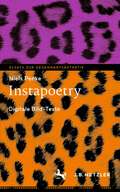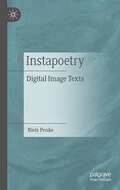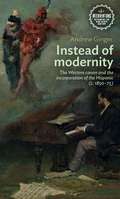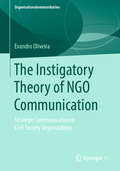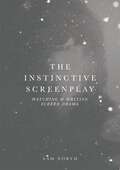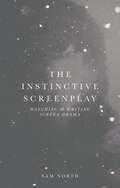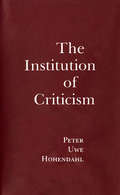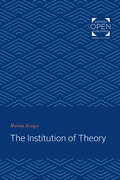- Table View
- List View
Instagram-Journalismus: Ein Leitfaden für Redaktionen und freie Journalisten (essentials)
by Selina BettendorfSelina Bettendorf bietet Social-Media-Redakteuren einen einfachen und praktischen Leitfaden, wie sie professionellen Instagram-Journalismus betreiben können. Instagram ist eine Social-Media-Plattform, auf der Bilder und Videos auf einer Startseite (Feed) und in einem neuen Storyformat geteilt werden und die vor allem von jungen Menschen genutzt wird. Die Anzahl der Nutzer wächst rasant; so wird Instagram in der Zukunft des Journalismus eine ausschlaggebende Rolle spielen. Die Autorin thematisiert deshalb, wie Instagram-Beiträge im Feed möglichst viele Menschen erreichen und wie sich Medienunternehmen erfolgreich auf der Plattform präsentieren können. Außerdem erklärt sie, wie qualitativ hochwertiger Journalismus in den Instagram-Storys funktioniert und wie aus Instagram-Followern regelmäßige Besucher der Homepage oder E-Paper-Leser werden können.Die Autorin: Selina Bettendorf ist Absolventin des Masterstudiengangs Medien-Ethik-Religion an der FAU Erlangen-Nürnberg und arbeitet nun als Volontärin bei einer Berliner Tageszeitung.
Instagram-Journalismus für die Praxis: Ein Leitfaden für Journalismus und Öffentlichkeitsarbeit
by Selina BettendorfDieses Buch bietet einen praktischen Leitfaden für Journalismus auf Instagram. Es gibt sowohl die Grundlagen für Instagram-Journalismus, als auch Tipps und Tricks für Profis. Deshalb spielt es keine Rolle, ob die Leserin oder der Leser mit der Plattform schon vertraut ist oder noch nicht. Instagram ist die Plattform, um junge Menschen zu erreichen. Es wird erklärt, wie durch gute Inhalte auf der Plattform aus Instagram-Followern regelmäßige Besucher*innen der Homepage oder E-Paper-Leser*innen werden können. Zusätzlich gibt es Anleitungen für die Community-Arbeit und Ideen, wie Instagram als Recherchequelle genutzt werden kann. Außerdem bietet das Buch praktische Informationen für TV- und Radiojournalist*innen und eine Einführung in Instagram für die Öffentlichkeitsarbeit.
The Instant World Report: Canada's Role in Shaping the Right to Communicate (Global Transformations in Media and Communication Research - A Palgrave and IAMCR Series)
by Aliaa DakrouryThis book proposal focuses on Canada's pioneering role in shaping the international understanding of the right to communicate, particularly through the Canadian Telecommission Studies of 1969. The study argues that the 1971 Instant World report, a landmark document, has been overlooked in the existing literature despite its importance in the history of conceptualizing and implementing this human right. The project aims to fill this gap by exploring the historical context of the report and analyzing its contents, shedding light on themes like privacy and indigenous communication rights. Additionally, the manuscript highlights the unique contribution of Betty Zimmerman, the only female Canadian member of the MacBride Commission in 1977, replacing Marshall McLuhan. Zimmerman's insights become pertinent not only for scholars interested in the New World Information and Communication Order but also for feminist studies, showcasing a leading female figure's role in Canadian communication and cultural policy. The research promises a novel and untold perspective on the history of the right to communicate, addressing gaps in international and Canadian communication, women’s studies, and media policy literature.
Instapoetry: Digitale Bild-Texte (Essays zur Gegenwartsästhetik)
by Niels PenkeInstapoetry zählt zu den populärsten literarischen Phänomenen der Gegenwart. In wenigen Jahren sind Millionen von kurzen bis ultra-kurzen Texten auf Instagram publiziert und geteilt worden. Im Kampf um Aufmerksamkeit mit unzähligen anderen Texten müssen die Mechanismen der Plattform und die Nutzungsroutinen der User bedient werden. Der äußere Druck auf die literarische Produktion ist immens. Das Buch erklärt die Produktionsstrategien und Rezeptionsverfahren von Instapoetry, erläutert ihre Entwicklung und verortet ihre Bedeutung – irgendwo zwischen letzter Verfallsstufe und Zukunft der Lyrik.
Instapoetry: Digital Image Texts
by Niels PenkeInstapoetry is one of the most popular literary phenomena of our time. In just a few years, millions of short to ultra-short texts have been published and shared on Instagram. In the battle for attention with countless other texts, the mechanisms of the platform and the usage routines of the users have to be served. The external pressure on literary production is immense. The book explains the production strategies and reception procedures of Instapoetry, explains its development and locates its significance - somewhere between the last stage of decay and the future of poetry.
Instauration der Erde: Konstitutives Erzählen im Anthropozän und die kritischen Zonen der Literatur (Environmental Humanities #2)
by Simon ProbstMit dem Anthropozän wird oft das Entstehen einer planetaren Universalität und die ‚Wiederkehr der großen Erzählungen‘ verknüpft. Die Verflechtungen von Menschen und Erde werden hier zur Grundlage kultureller Selbstverständigung. Das Buch untersucht strukturelle Merkmale und Problemkonstellationen dieser erdgebundenen konstitutiven Erzählungen. Wie können sie globale Ungleichheiten berücksichtigen? Wie lassen sie die Erde und andere Spezies zu Wort kommen? Inwiefern sind diese Erzählungen selbst planetare Kräfte? Und: Wie kann das Eigenwissen der Literatur unseren Blick auf die Erde erweitern? Diese Fragen werden im Dialog von Wissenschaft und Literatur untersucht. Eingehende Lektüren verbinden kanonische Texten des Anthropozän-Diskurses (z.B. Dipesh Chakrabarty, Donna Haraway, Bruno Latour und Isabelle Stengers) mit literarischen Stimmen (Ursula K. Le Guin, Daniel Falb, Christoph Ransmayr).
Instead of modernity: The Western canon and the incorporation of the Hispanic (c. 1850–75) (Interventions: Rethinking the Nineteenth Century)
by Andrew GingerThis book revisits the claim that a key dimension of cultural modernity – understood as a turn to the autonomy of the signs and the erasure of the 'face of man' - arose in the mid-nineteenth century. It presents an alternative to that obsession, focusing instead on the aesthetic appreciation of forms through which connections are realised across place and time. The book is one of few to offer a comparative approach to numerous major writers and artists of this period over diverse countries. Specifically, the comparative approach overcomes the constitutively ambiguous relation between the modern and the Hispanic. The Hispanic is often imagined as at once foundational for and excluded from the modern world. Its reincorporation into the story of the mid-century unsettles the notion of modernity. The book offers instead an experiment in writing, tracing commonalities across place and time, and drawing on mid-century expressions of such likenesses.
Instead of modernity: The Western canon and the incorporation of the Hispanic (c. 1850–75) (Interventions: Rethinking the Nineteenth Century)
by Andrew GingerThis book revisits the claim that a key dimension of cultural modernity – understood as a turn to the autonomy of the signs and the erasure of the 'face of man' - arose in the mid-nineteenth century. It presents an alternative to that obsession, focusing instead on the aesthetic appreciation of forms through which connections are realised across place and time. The book is one of few to offer a comparative approach to numerous major writers and artists of this period over diverse countries. Specifically, the comparative approach overcomes the constitutively ambiguous relation between the modern and the Hispanic. The Hispanic is often imagined as at once foundational for and excluded from the modern world. Its reincorporation into the story of the mid-century unsettles the notion of modernity. The book offers instead an experiment in writing, tracing commonalities across place and time, and drawing on mid-century expressions of such likenesses.
The Instigatory Theory of NGO Communication: Strategic Communication in Civil Society Organizations (Organisationskommunikation)
by Evandro OliveiraBy understanding the ontogenesis of NGOs as civil society organizations from a historical-anthropological, communicational, sociological, economical and managerial perspective, Evandro Oliveira outlines the Instigatory Theory of NGO Communication (ITNC). This proposes the ontological principles, an applied conceptual model and a cybernetic operational model for understanding and managing communication at NGOs. Those models were tested using a mixed-method research design.
The Instinctive Screenplay: Watching and Writing Screen Drama
by Sam NorthWhat is it that makes humans engage with a dramatic narrative? Is it linked to our primitive selves, contained within our instinctive experience? This innovative text argues that understanding how and why our human instincts are brought into play as we watch screen drama is the key to writing it. Analysing four powerful instincts – willpower, logic, morality and emotion – Sam North explores how they determine our level of involvement in their drama, and how screenwriters can use them to develop their craft. Including a variety of both well-known and less famous examples, from The Shawshank Redemption to Samira Makhmalbaf’s The Apple, this book offers a fresh new approach to thinking about, discussing and writing screenplays.
The Instinctive Screenplay: Watching and Writing Screen Drama
by Sam NorthWhat is it that makes humans engage with a dramatic narrative? Is it linked to our primitive selves, contained within our instinctive experience?This innovative text argues that understanding how and why our human instincts are brought into play as we watch screen drama is the key to writing it. Analysing four powerful instincts – willpower, logic, morality and emotion – Sam North explores how they determine our level of involvement in their drama, and how screenwriters can use them to develop their craft. Including a variety of both well-known and less famous examples, from The Shawshank Redemption to Samira Makhmalbaf's The Apple, this book offers a fresh new approach to thinking about, discussing and writing screenplays.
The Institution of Criticism
by Peter Uwe HohendahlGerman radicals of the 1960s announced the death of literature. For them, literature both past and present, as well as conventional discussions of literary issues, had lost its meaning. In The Institution of Criticism, Peter Uwe Hohendahl explores the implications of this crisis from a Marxist perspective and attempts to define the tasks and responsibilities of criticism in advanced capitalist societies. Hohendahl takes a close look at the social history of literary criticism in Germany since the eighteenth century. Drawing on the tradition of the Frankfurt School and on Jürgen Habermas’s concept of the public sphere, Hohendahl sheds light on some of the important political and social forces that shape literature and culture. The Institution of Criticism is made up of seven essays originally published in German and a long theoretical introduction written by the author with English-language readers in mind. This book conveys the rich possibilities of the German perspective for those who employ American and French critical techniques and for students of contemporary critical theory.
The Institution of Theory
by Murray KriegerIn The Institution of Theory, Murray Krieger examines, at once sympathetically and critically, the process by which theory has become institutionalized in the American academy and the consequences of theory as an academic institution. He traces the transformation of literary theory into critical theory and relates it to changes in the place of literature within questions about discourse at large. And he faces the costs as well as the gains of the recent denial of privilege to the literary. To support his view of the issues at stake in current theoretical debates, Krieger surveys both the history of American criticism and the general history of literary theory in the West. He sees divisions in each of them that foreshadow the current debates: in the first a conflict between the social and the aesthetic functions of literature, and in the second a conflict between the treatment of literature as a reflection of a culture's ideology and the treatment of literature as a subversion of that ideology. To what extent, he asks, are our debates new and to what extent are they merely refashioned versions of those we have always had?
The Institution of Theory
by Murray KriegerOriginally published in 1994. In The Institution of Theory, Murray Krieger examines, at once sympathetically and critically, the process by which theory has become institutionalized in the American academy and the consequences of theory as an academic institution. He traces the transformation of literary theory into critical theory and relates it to changes in the place of literature within questions about discourse at large. And he faces the costs as well as the gains of the recent denial of privilege to the literary. To support his view of the issues at stake in current theoretical debates, Krieger surveys both the history of American criticism and the general history of literary theory in the West. He sees divisions in each of them that foreshadow the current debates: in the first a conflict between the social and the aesthetic functions of literature, and in the second a conflict between the treatment of literature as a reflection of a culture's ideology and the treatment of literature as a subversion of that ideology. To what extent, he asks, are our debates new and to what extent are they merely refashioned versions of those we have always had?
Institutional Ethnography: A Theory of Practice for Writing Studies Researchers
by Michelle LaFranceA form of critical ethnography introduced to the social sciences in the late 1990s, institutional ethnography uncovers how things happen within institutional sites, providing a new and flexible tool for the study of how “work” is co-constituted within sites of writing and writing instruction. The study of work and work processes reveals how institutional discourse, social relations, and norms of professional practice coordinate what people do across time and sites of writing. Adoption of IE offers finely grained understandings of how our participation in the work of writing, writing instruction, and sites of writing gives material face to the institutions that govern the social world. In this book, Michelle LaFrance introduces the theories, rhetorical frames, and methods that ground and animate institutional ethnography. Three case studies illustrate key aspects of the methodology in action, tracing the work of writing assignment design in a linked gateway course, the ways annual reviews coordinate the work of faculty and writing center administrators and staff, and how the key term “information literacy” socially organizes teaching in a first-year English program. Through these explorations of the practice of ethnography within sites of writing and writing instruction, LaFrance shows that IE is a methodology keenly attuned to the material relations and conditions of work in twenty-first-century writing studies contexts, ideal for both practiced and novice ethnographers who seek to understand the actualities of social organization and lived experience in the sites they study. Institutional Ethnography expands the field’s repertoire of research methodologies and offers the grounding necessary for work with the IE framework. It will be invaluable to writing researchers and students and scholars of writing studies across the spectrum—composition and rhetoric, literacy studies, and education—as well as those working in fields such as sociology and cultural studies.
Institutional Literacies: Engaging Academic IT Contexts for Writing and Communication
by Stuart A. SelberInformation technologies have become an integral part of writing and communication courses, shaping the ways students and teachers think about and do their work. But, too often, teachers and other educational stakeholders take a passive or simply reactive role in institutional approaches to technologies, and this means they are missing out on the chance to make positive changes in their departments and on campus. Institutional Literacies argues that writing and communication teachers and program directors should collaborate more closely and engage more deeply with IT staff as technology projects are planned, implemented, and expanded. Teachers need to both analyze how their institutions approach information technologies and intervene in productive ways as active university citizens with relevant expertise. To help them do so, the book offers a three-part heuristic, reflecting the reality that academic IT units are complex and multilayered, with historical, spatial, and textual dimensions. It discusses six ways teachers can intervene in the academic IT work of their own institutions: maintaining awareness, using systems and services, mediating for audiences, participating as user advocates, working as designers, and partnering as researchers. With these strategies in hand, educators can be proactive in helping institutional IT approaches align with the professional values and practices of writing and communication programs.
Institutional Literacies: Engaging Academic IT Contexts for Writing and Communication
by Stuart A. SelberInformation technologies have become an integral part of writing and communication courses, shaping the ways students and teachers think about and do their work. But, too often, teachers and other educational stakeholders take a passive or simply reactive role in institutional approaches to technologies, and this means they are missing out on the chance to make positive changes in their departments and on campus. Institutional Literacies argues that writing and communication teachers and program directors should collaborate more closely and engage more deeply with IT staff as technology projects are planned, implemented, and expanded. Teachers need to both analyze how their institutions approach information technologies and intervene in productive ways as active university citizens with relevant expertise. To help them do so, the book offers a three-part heuristic, reflecting the reality that academic IT units are complex and multilayered, with historical, spatial, and textual dimensions. It discusses six ways teachers can intervene in the academic IT work of their own institutions: maintaining awareness, using systems and services, mediating for audiences, participating as user advocates, working as designers, and partnering as researchers. With these strategies in hand, educators can be proactive in helping institutional IT approaches align with the professional values and practices of writing and communication programs.
Institutional Literacies: Engaging Academic IT Contexts for Writing and Communication
by Stuart A. SelberInformation technologies have become an integral part of writing and communication courses, shaping the ways students and teachers think about and do their work. But, too often, teachers and other educational stakeholders take a passive or simply reactive role in institutional approaches to technologies, and this means they are missing out on the chance to make positive changes in their departments and on campus. Institutional Literacies argues that writing and communication teachers and program directors should collaborate more closely and engage more deeply with IT staff as technology projects are planned, implemented, and expanded. Teachers need to both analyze how their institutions approach information technologies and intervene in productive ways as active university citizens with relevant expertise. To help them do so, the book offers a three-part heuristic, reflecting the reality that academic IT units are complex and multilayered, with historical, spatial, and textual dimensions. It discusses six ways teachers can intervene in the academic IT work of their own institutions: maintaining awareness, using systems and services, mediating for audiences, participating as user advocates, working as designers, and partnering as researchers. With these strategies in hand, educators can be proactive in helping institutional IT approaches align with the professional values and practices of writing and communication programs.
Institutional Literacies: Engaging Academic IT Contexts for Writing and Communication
by Stuart A. SelberInformation technologies have become an integral part of writing and communication courses, shaping the ways students and teachers think about and do their work. But, too often, teachers and other educational stakeholders take a passive or simply reactive role in institutional approaches to technologies, and this means they are missing out on the chance to make positive changes in their departments and on campus. Institutional Literacies argues that writing and communication teachers and program directors should collaborate more closely and engage more deeply with IT staff as technology projects are planned, implemented, and expanded. Teachers need to both analyze how their institutions approach information technologies and intervene in productive ways as active university citizens with relevant expertise. To help them do so, the book offers a three-part heuristic, reflecting the reality that academic IT units are complex and multilayered, with historical, spatial, and textual dimensions. It discusses six ways teachers can intervene in the academic IT work of their own institutions: maintaining awareness, using systems and services, mediating for audiences, participating as user advocates, working as designers, and partnering as researchers. With these strategies in hand, educators can be proactive in helping institutional IT approaches align with the professional values and practices of writing and communication programs.
Institutional Translation and Interpreting: Assessing Practices and Managing for Quality (Routledge Advances in Translation and Interpreting Studies)
by Fernando Prieto RamosThis collection brings together new insights around current translation and interpreting practices in national and supranational settings. The book illustrates the importance of further reflection on issues around quality and assessment, given the increased development of resources for translators and interpreters. The first part of the volume focuses on these issues as embodied in case studies from a range of national and regional contexts, including Finland, Switzerland, Italy, Spain and the United States. The second part takes a broader perspective to look at best practices and questions of quality through the lens of international bodies and organizations and the shifting roles of translation and interpreting practitioners in working to manage these issues. Taken together, this collection demonstrates the relevance of critically examining processes, competences and products in current institutional translation and interpreting settings at the national and supranational levels, paving the way for further research and quality assurance strategies in the field.
Institutional Translation and Interpreting: Assessing Practices and Managing for Quality (Routledge Advances in Translation and Interpreting Studies)
by Fernando Prieto RamosThis collection brings together new insights around current translation and interpreting practices in national and supranational settings. The book illustrates the importance of further reflection on issues around quality and assessment, given the increased development of resources for translators and interpreters. The first part of the volume focuses on these issues as embodied in case studies from a range of national and regional contexts, including Finland, Switzerland, Italy, Spain and the United States. The second part takes a broader perspective to look at best practices and questions of quality through the lens of international bodies and organizations and the shifting roles of translation and interpreting practitioners in working to manage these issues. Taken together, this collection demonstrates the relevance of critically examining processes, competences and products in current institutional translation and interpreting settings at the national and supranational levels, paving the way for further research and quality assurance strategies in the field.
Institutional Translation for International Governance: Enhancing Quality in Multilingual Legal Communication (Bloomsbury Advances in Translation)
by Fernando Prieto RamosThis volume provides a state-of-the-art overview of institutional translation issues related to the development of international law and policies for supranational integration and governance. These issues are explored from various angles in selected papers by guest specialists and findings of a large-scale research project led by the editor.Focus is placed on key methodological and policy aspects of legal communication and translation quality in a variety of institutional settings, including several comparative studies of the United Nations and European Union institutions. The first book of its kind on institutional translation with a focus on quality of legal communication, this work offers a unique combination of perspectives drawn together through a multilayered examination of methods (e.g. corpus analysis, comparative law for translation and terminological analysis), skills and working procedures. The chapters are organized into three sections: (1) contemporary issues and methods; (2) translation quality in law- and policy-making and implementation; and (3) translation and multilingual case-law.
Institutional Translation for International Governance: Enhancing Quality in Multilingual Legal Communication (Bloomsbury Advances in Translation)
by Fernando Prieto RamosThis volume provides a state-of-the-art overview of institutional translation issues related to the development of international law and policies for supranational integration and governance. These issues are explored from various angles in selected papers by guest specialists and findings of a large-scale research project led by the editor.Focus is placed on key methodological and policy aspects of legal communication and translation quality in a variety of institutional settings, including several comparative studies of the United Nations and European Union institutions. The first book of its kind on institutional translation with a focus on quality of legal communication, this work offers a unique combination of perspectives drawn together through a multilayered examination of methods (e.g. corpus analysis, comparative law for translation and terminological analysis), skills and working procedures. The chapters are organized into three sections: (1) contemporary issues and methods; (2) translation quality in law- and policy-making and implementation; and (3) translation and multilingual case-law.
Institutional Translator Training (Routledge Advances in Translation and Interpreting Studies)
by Vilelmini Sosoni 321 Ucja Biel Tomás SvobodaThis collection surveys the translator training landscape in international organizations on a global scale, offering a state-of-the-art view on institutional translator training research and practical takeaways for stakeholders. The volume’s focus on training brings a unique perspective to existing research on institutional translation, which has tended to single out such themes as agency, professionalism, and quality. The book is divided into three sections, with the first outlining the competences required of institutional translators, the second exploring training practices at the university level and "on the job", for novices and professionals, across a range of settings, and the third providing a synthesis of the above. Contributions draw on findings from studies in both institutional desiderata and existing training programmes from diverse geographic contexts towards situating the discussion through a global lens. In linking together competences and training practices, the book enhances collective knowledge of institutional translation and provides valuable insights for universities and institutions that work with translators on both international and national scales. This book will be key reading for scholars in translation studies, particularly those interested in institutional translation and translator training, as well as active professionals.
Institutional Translator Training (Routledge Advances in Translation and Interpreting Studies)
by Tomáš Svoboda, Łucja Biel, and Vilelmini SosoniThis collection surveys the translator training landscape in international organizations on a global scale, offering a state-of-the-art view on institutional translator training research and practical takeaways for stakeholders. The volume’s focus on training brings a unique perspective to existing research on institutional translation, which has tended to single out such themes as agency, professionalism, and quality. The book is divided into three sections, with the first outlining the competences required of institutional translators, the second exploring training practices at the university level and "on the job", for novices and professionals, across a range of settings, and the third providing a synthesis of the above. Contributions draw on findings from studies in both institutional desiderata and existing training programmes from diverse geographic contexts towards situating the discussion through a global lens. In linking together competences and training practices, the book enhances collective knowledge of institutional translation and provides valuable insights for universities and institutions that work with translators on both international and national scales. This book will be key reading for scholars in translation studies, particularly those interested in institutional translation and translator training, as well as active professionals.



